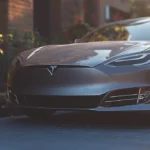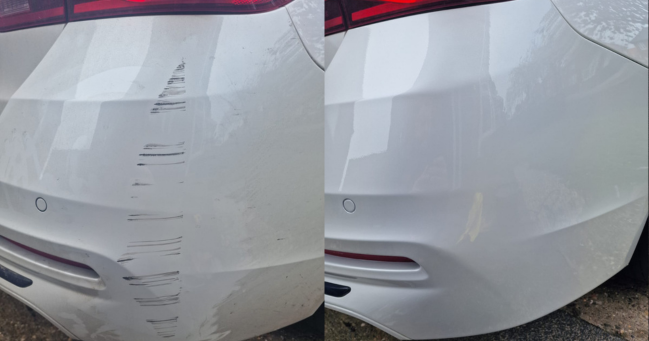
- March 27, 2025
Everything You Need to Know About Car Paint: From Creation to Care
Car paint isn’t just about making your motor look smart — it’s a complex protective system that preserves your vehicle’s value and appearance. Whether you’re a car enthusiast, a weekend detailer, or simply curious about what’s going on with your car’s finish, this guide will walk you through everything you need to know.
1. How Car Paint is Made
Modern car paint is a brilliant blend of chemistry and colour science. It’s not just a simple splash of paint, but a carefully engineered system typically consisting of four key layers:
• E-coat (electrocoat): The unsung hero that prevents your car from turning into a rust bucket.
• Primer: Think of this as the perfect base layer that helps the paint stick and creates a smooth canvas.
• Basecoat: This is where the magic happens — the visible colour that can come in solid, metallic, or pearlescent finishes.
• Clearcoat: A transparent protective layer that gives your car that showroom shine and shields against UV rays and minor scrapes.
Car manufacturers aren’t just painting cars — they’re running high-tech paint laboratories. Robots spray multiple layers in completely dust-free environments, using a clever mix of pigments, resins, solvents, and additives to create a finish that can handle everything the British weather throws at it.
2. How Long Does Car Paint Take to Dry?
Drying time isn’t a one-size-fits-all affair. It depends on the type of paint and the conditions:
• Air-dry (conventional) paint: Can take a patience-testing 24 to 48 hours to cure fully.
• Two-pack (2K) paint: A clever chemical process that hardens much quicker, often within a few hours.
• Water-based paints: Generally faster to dry, but still needing a clearcoat for proper protection.
Professional body shops have fancy infrared lamps and heated spray booths to speed things up. At home, without precise temperature and humidity control, you’ll need a lot more patience.
3. How to Find Your Car’s Paint Code
Want an exact colour match? You’ll need to hunt down your car’s unique paint code. Check these spots:
• Inside the driver-side door jamb
• Under the bonnet
• In the boot (near the spare wheel well)
• In the owner’s manual or service book
Pro tip: These codes are more specific than you might think. Two cars that look identical can have different paint codes due to manufacturing batches.
4. Can Car Paint Be Matched Exactly?
Yes — but it’s not always straightforward. Bodyshops use high-tech paint-matching systems and spectrophotometers to get as close to perfect as possible. However, factors like paint ageing, sun exposure, and previous repairs can make an exact match tricky.
Experienced technicians have a clever trick — they’ll blend the new paint into surrounding panels to make any difference completely invisible.
5. Can Car Paint Dry in Cold Weather?
It can, but it’s not ideal. Cold temperatures are a bit of a nightmare for paint jobs. They slow down solvent evaporation and the chemical curing process. Paint can end up tacky or uneven if applied below about 15°C.
For mobile repairs, this is particularly challenging during UK winters. Professionals combat this with heated drying systems, weather protection, and specialist low-temperature curing products.
6. Why Does Car Paint Crack?
Cracking can happen for several reasons:
• Ageing and oxidation
• Dodgy application of incompatible paint types
• Poor surface preparation
• Extreme temperature exposure
• Flexing or movement in panels
Once cracking starts, it’s bad news. Water and debris can get underneath, potentially leading to rust or more extensive damage. Early detection and fixing are crucial.
7. Why Does Car Paint Fade?
UV exposure is the main culprit here. Sunlight breaks down paint pigments over time, with reds and darker shades particularly vulnerable. Other contributing factors include:
• Acid rain
• Pollution
• Aggressive bird droppings
• Harsh cleaning chemicals
Clearcoats help, but once they degrade, colour loss speeds up. Regular washing, waxing, and keeping your car sheltered can dramatically slow down fading.
We’ve actually written a whole blog post on why car paint fades here.
8. Why Does Car Paint Peel Off?
Paint peeling happens when the bond between layers fails, typically due to:
• Poor surface preparation
• Impact or damage
• Extreme element exposure
• Low-quality paint or incorrect application
• Clearcoat failure
Once peeling starts, it spreads like wildfire. The best approach is to remove and reapply the affected area before it gets worse.
9. Which Car Paint Colour Lasts Longest?
Lighter, neutral colours like white, silver, and beige are the champions of longevity. They reflect UV rays more effectively and fade slower. Darker colours like reds and blacks look stunning but absorb more heat, accelerating oxidation.
Pearlescent and metallic finishes might turn heads, but they can be trickier to maintain. Remember, proper care matters more than the colour itself.
10. When to Wash a Car After a Paint Job
Patience is key after a fresh paint job:
• First 24–48 hours: Avoid washing altogether
• After 2–4 days: A gentle water rinse is usually safe
• After 30 days: Back to regular washing and waxing
Harsh chemicals or pressure washers too soon can wreak havoc on a new finish.
Final Thoughts
Car paint is more than just a pretty face – it’s a technical system designed to protect your vehicle and maintain its value. Understanding how it works helps you make smarter decisions about your car’s care.
Need expert help with a paint issue? Mobile repair services can bring professional solutions right to your doorstep, ensuring a flawless finish come rain or shine.


